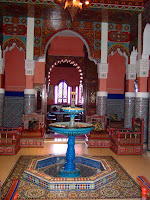 "Sweeping cobwebs from the edges of my mind
"Sweeping cobwebs from the edges of my mindHad to get away to see what we could find"
Our second early start took us west to the coast to visit Essaouira.
 En route we stopped to see the production of argan oil. The Argan trees only grow in this area of Morocco and in Mexico. Goats climb the trees and eat the fruit, spitting out the nuts. Women collect these reject stones as well as shaking the trees to get more nuts, split them to get the bitter almond-like kernel. At that point, they are ground for cosmetic oil or roast then ground to make cooking oil.
En route we stopped to see the production of argan oil. The Argan trees only grow in this area of Morocco and in Mexico. Goats climb the trees and eat the fruit, spitting out the nuts. Women collect these reject stones as well as shaking the trees to get more nuts, split them to get the bitter almond-like kernel. At that point, they are ground for cosmetic oil or roast then ground to make cooking oil.  From 100kg of the fruit – only harvested once the fruit has shrivelled and lost most of the moisture, they achieve 1 litre of oil. However, nothing is wasted: by-products include animal feed and fuel for fires.
From 100kg of the fruit – only harvested once the fruit has shrivelled and lost most of the moisture, they achieve 1 litre of oil. However, nothing is wasted: by-products include animal feed and fuel for fires.Essaouira was designed by a French architect, in 1765, at the request of Sultan Sidi Mohammed, ben Abdallah. Before the town was built a plan was displayed and the name is derived from the local language for ‘look at the picture’.
 The ‘new’ town was built behind the Portuguese fort of Mogador and as a planned town it is well laid out with wide main avenues running in ‘cross’ arrangement. Behind the shopping area, the normal narrow maze of streets takes over.
The ‘new’ town was built behind the Portuguese fort of Mogador and as a planned town it is well laid out with wide main avenues running in ‘cross’ arrangement. Behind the shopping area, the normal narrow maze of streets takes over.

Whereas Marrakech is red, Essaouira is predominately white with blue trim. This theme carries over into the port, where the small boats are all blue as are the taxis bicycles and hand carts.
 Whether being on the coast, with a beautiful beach nearby was the reason or not, we really enjoyed the atmosphere of the town, which seems very relaxed and friendly, with a lot less ‘hard-sell’ from the vendors.
Whether being on the coast, with a beautiful beach nearby was the reason or not, we really enjoyed the atmosphere of the town, which seems very relaxed and friendly, with a lot less ‘hard-sell’ from the vendors.

































